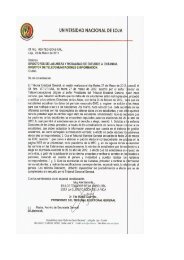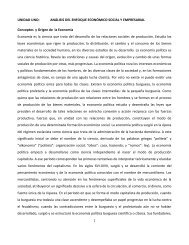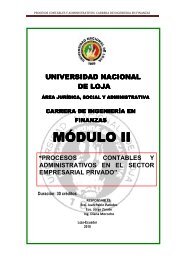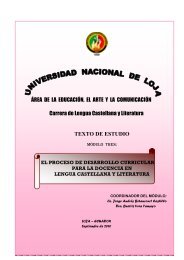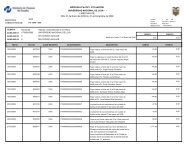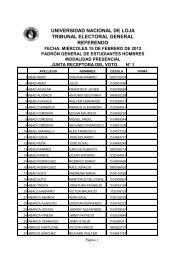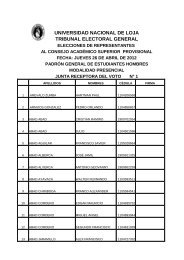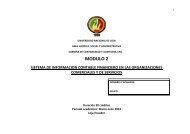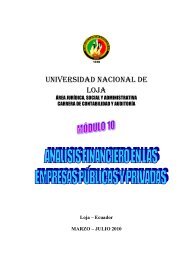module 5 planning of the english language teaching-learning process
module 5 planning of the english language teaching-learning process
module 5 planning of the english language teaching-learning process
You also want an ePaper? Increase the reach of your titles
YUMPU automatically turns print PDFs into web optimized ePapers that Google loves.
UNIVERSIDAD NACIONAL DE LOJA<br />
Área de la Educación el Arte y la Comunicación<br />
English Language Career<br />
1. Teacher correction. The teacher corrects <strong>the</strong> learners' mistakes by<br />
writing <strong>the</strong> correct word(s), instead <strong>of</strong> symbols from a correction code.<br />
2. Peer correction. The learners look at each o<strong>the</strong>r's work and correct it or<br />
discuss possible corrections.<br />
3. Self-correction. The learners, usually with <strong>the</strong> help <strong>of</strong> a guidance sheet,<br />
look for and correct mistakes in <strong>the</strong>ir own work.<br />
4. Ignoring <strong>the</strong> mistake. As in point 9 above, sometimes we choose to<br />
ignore mistakes that learners make.<br />
<br />
Key concepts and <strong>the</strong> <strong>language</strong> <strong>teaching</strong> classroom<br />
• In <strong>the</strong> classroom, we use a mix <strong>of</strong> teacher correction, peer correction and<br />
self-correction. Sometimes we need to correct learners. Sometimes we<br />
indicate to <strong>the</strong>m that <strong>the</strong>re is a mistake and <strong>the</strong>y are able to correct<br />
<strong>the</strong>mselves or o<strong>the</strong>r learners can help <strong>the</strong>m. Sometimes we ignore learners'<br />
mistakes. We choose what is appropriate for <strong>the</strong> <strong>learning</strong> purpose, <strong>the</strong><br />
learner and <strong>the</strong> situation.<br />
• The technique we use for correcting mistakes depends on <strong>the</strong> type <strong>of</strong><br />
mistake <strong>the</strong> learner has made. For example, we can use echo correction for<br />
slips, and time lines for errors.<br />
• We do not correct every mistake our learners make. We correct mistakes<br />
according to <strong>the</strong> purpose <strong>of</strong> <strong>the</strong> activity, <strong>the</strong> stage in <strong>the</strong> lesson, <strong>the</strong><br />
seriousness <strong>of</strong> <strong>the</strong> mistake and <strong>the</strong> learner's needs. It is inappropriate to<br />
correct all <strong>the</strong> mistakes learners make, and it can make learners lose<br />
motivation. When learners are doing a fluency activity, correction after <strong>the</strong><br />
activity would be more appropriate.<br />
• Some correction techniques are more suitable for certain types <strong>of</strong> mistake.<br />
For example, finger correction is useful for pronunciation mistakes and time<br />
lines are useful for mistakes with tenses.<br />
• Techniques such as gestures and facial expressions give opportunities for<br />
peer and self-correction. This is because we show <strong>the</strong> learners that <strong>the</strong>re is<br />
a mistake but we do not correct it.<br />
FOLLOW-UP ACTIVITIES<br />
Look at <strong>the</strong> following pairs <strong>of</strong> sentences. Learners <strong>of</strong>ten make mistakes and<br />
confuse <strong>the</strong> meaning <strong>of</strong> A and B in each pair. Draw two time lines for each pair<br />
which dearly show <strong>the</strong> differences in meaning.<br />
1 A Cinderella danced with <strong>the</strong> prince when <strong>the</strong> dock struck midnight.<br />
B Cinderella was dancing with <strong>the</strong> prince when <strong>the</strong> clock struck midnight.<br />
2 A I play tennis on Fridays.<br />
B I played tennis on Friday.<br />
REFECTION<br />
Think about <strong>the</strong>se comments from teachers. Which do you agree with and why?<br />
1 When learners make mistakes it means that <strong>the</strong>y are not <strong>learning</strong>.<br />
[Escribir texto] Página 109



